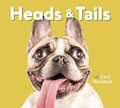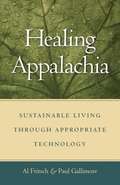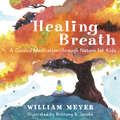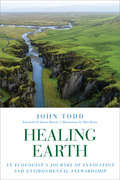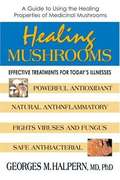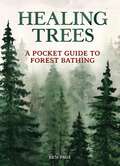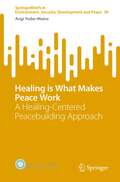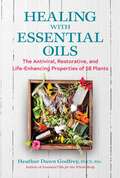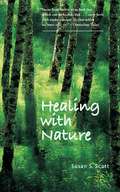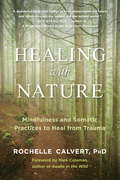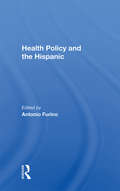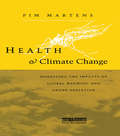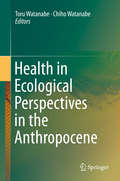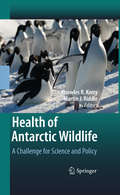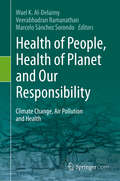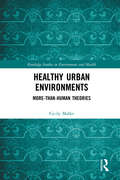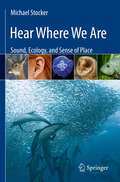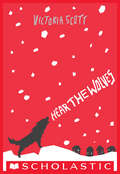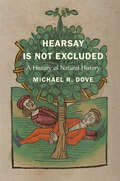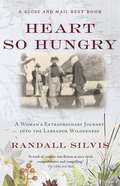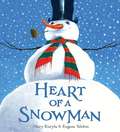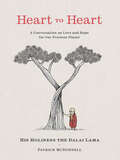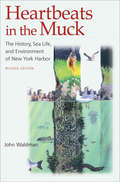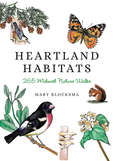- Table View
- List View
Heads & Tails
by Carli DavidsonFrom wet noses to fuzzy paws, babies and toddlers will love learning the parts of the body from the adorable dogs and puppies in Heads & Tails. With lively images from the lens of expert animal photographer Carli Davidson, this sturdy book is perfect for the very youngest readers—and fun for the whole family.
Heal the Earth (Julian Lennon White Feather Flier Advent #2)
by Bart Davis Smiljana Coh Julian LennonTake a journey to help the Earth in the second book of the New York Times bestselling trilogy by Julian Lennon!Jump aboard the White Feather Flier, a magical plane that can go wherever you want. This time, Lennon’s interactive book immerses children in a fun and unique journey where they can: Bring medicine to people in need! Dive below the ocean to bleached coral reefs! Visit the city to cultivate green spaces! Help the rain forest return and give its animals a home! Explore the planet, meet new people, and help make the world a better place!The Flier's mission is to transport readers around the world, to engage them in helping to save the environment, and to teach one and all to love our planet. Just press a button printed on the page, and point the plane up in the air to fly, or down to land it!An inspiring, lyrical story, rooted in Lennon's life and work, Heal the Earth is filled with beautiful illustrations that bring the faraway world closer to young children. The book includes words to a new, special poem written by Julian Lennon, specifically for Heal the Earth. A portion of the proceeds from book sales will go to support the environmental and humanitarian efforts of the White Feather Foundation, the global environmental and humanitarian organization that Lennon founded to promote education, health, conservation, and the protection of indigenous culture.
Healing Appalachia: Sustainable Living through Appropriate Technology
by Al Fritsch Paul GallimoreHealing Appalachia is a practical guide for environmentally conscious residents of Appalachia and beyond. Each section of the book includes details on construction and maintenance, as well as resources for locating further information, making this an essential volume for everyone who cares about the future of Appalachia.
Healing Breath: A Guided Meditation through Nature for Kids
by William MeyerA gorgeously illustrated guided meditation to calm and soothe as well as inspire and empower us to act on behalf of the natural world Join the award-winning team of writer and teacher Bill Meyer and illustrator Brittany R. Jacobs on a guided meditation journey through rich, colorful landscapes spanning the globe. Breathe into the experience of waves on the ocean, trees in a forest, and the warmth of a desert, and feel your connection to all of life, from barnacles to baboons to falcons to farmers. This magical meditation-in-a-book is ideal for anyone who wants to simultaneously calm down and rise up to the world in all its wonders.
Healing Earth: An Ecologist's Journey of Innovation and Environmental Stewardship
by Matt Beam Janine Benyus John ToddA true pioneer and respected elder in ecological recovery and sustainability shares effective solutions he has designed and implemented.A stand-out from the sea of despairing messages about climate change, well-known sustainability elder John Todd, who has taught, mentored, and inspired such well-known names in the field as Janine Benyus, Bill McKibben, and Paul Hawken, chronicles the different ecological interventions he has created over the course of his career. Each chapter offers a workable engineering solution to an existing environmental problem: healing the aftermath of mountain-top removal and valley-fill coal mining in Appalachia, using windmills and injections of bacteria to restore the health of a polluted New England pond, working with community members in a South African village to protect an important river. A mix of both success stories and concrete suggestions for solutions to tackle as yet unresolved issues, Todd's narrative provides an important addition to the conversation about specific ways we can address the planetary crisis. Eighty-five color photos and images illustrate Todd's concepts. This is a refreshingly hopeful, proactive book and also a personal story that covers a known practitioner's groundbreaking career.
Healing Mushrooms: Effective Treatments for Today's Illnesses
by Georges M. HalpernFor over five thousand years, mushrooms have been used as an effective medicine. Now, researchers are rediscovering the amazing value of these traditional medicinals as well as uncovering new benefits--benefits that can safely and naturally improve your health and well-being. Written by Dr. Georges M. Halpern, a top medical scientist, this easy-to-use guide provides a fresh look at the history and uses of eight major healing mushrooms: maitake, reishi, shiitake, Cordyceps sinensis, Agaricus blazei, Phellinus linteus, Trametes versicolor, and Hericium erinaceus. From their use as a cholesterol-lowering agent to their anti-tumor activities to their promise of reversing Alzheimer's, mushrooms are some of nature's greatest wonders. Let Healing Mushrooms change the way you think about this marvelous medicinal.
Healing Trees: A Pocket Guide to Forest Bathing
by Ben PageTake a walk in the woods to find yourself. This book is intended as an easy approach to forest bathing, a concept that is now making its way into health and wellness practices. Part spiritual guide and part practitioner&’s handbook, this accessible, practical, positivity-rich book is designed to be taken on every walk to encourage mindfulness, contentedness, and presence in the moment. Written in a beautiful, encouraging style by a highly qualified and mediagenic author, the book also contains amazing hand-drawn illustrations of forest scenes.
Healing is What Makes Peace Work: A Healing-Centered Peacebuilding Approach (SpringerBriefs in Environment, Security, Development and Peace #39)
by Angi Yoder-MainaThe book goes beyond mental health and psychosocial support (MHPSS) to a holistic approach centered on healing. The book lays at the intersection of peacebuilding, global mental health, and development. In many parts of the world, entire generations live in chronic violence—just surviving. The exposure to violence has long-lasting effects which are not well accounted for in conflict analysis, stabilization efforts, peacebuilding, and governance initiatives. Extreme exposure to violence, abuse, neglect, and marginalization negatively affects levels of resilience and the ability of affecting the transition from violence to peace. A healing-centered peacebuilding approach requires fundamental changes in how systems are designed, organizations function, and practitioners engage with people, their communities, and their institutions. Key elements of the practice-based approach included inclusion, customization and contextualization, breaking cycles of violence, systems thinking, and trauma-informed tools. The approach considers emotional distress to be a critical variable in violent conflict and instability. Trauma is not only a consequence of violence, but also a cause of instability.
Healing with Essential Oils: The Antiviral, Restorative, and Life-Enhancing Properties of 58 Plants
by Heather Dawn Godfrey• Explains what an essential oil is and examines the botany of how they evolved and the various roles they play, from protecting the plant to aiding its propagation • Provides in-depth profiles for 58 common essential oils, identifying the phytochemicals that contribute to each oil&’s scent and healing qualities and its therapeutic applications, with an emphasis on antimicrobial and antiviral properties • Discusses the healthiest and safest ways to use essential oils for self-care and the safe and appropriate use of essential oils for children, the elderly, and those with compromised immune systems Exploring the journey of essential oils from living plant to bottle, as well as how to apply them in your own life for healing and balance, Heather Dawn Godfrey explains what an essential oil is and examines the botany of how they evolved and the various roles they play--from protecting the plant to aiding its propagation. She presents an easy-to-understand introduction to essential oil chemistry, detailing how essential oils are collected through various methods of extraction to preserve their healing properties. She then explores the healthiest and safest ways to use essential oils for self-care, including guidelines for children and the elderly as well as individuals with compromised immune systems.The author provides in-depth individual profiles for 58 common essential oils. Each profile includes a description of the plant the essential oil is extracted from, the phytochemicals and terpenes that comprise the essential oil, and the oil&’s aromatherapeutic applications. Godfrey explains how each chemical contributes to the essential oil&’s overall scent profile and therapeutic qualities, with particular focus on its antimicrobial, antiviral, restorative, and life-enhancing properties. She also details their subtle energetic properties, including their connections to the chakras and elements. Presenting an accessible yet scientifically based guide to healing with essential oils, this book provides a must-have reference for those who use essential oils at home, for health and well-being practitioners, for scent artists and blend creators, or for anyone wanting to explore the dynamic qualities of essential oils for themselves.
Healing with Nature
by Susan S. ScottSusan S. Scott is an experienced psychotherapist who, due to a back injury, was forced to abandon her therapist's couch and walk for therapy. Through her extended strolls through nature, she discovered the ingenious ability of trees to grow around obstacles and, in essence, heal themselves. The result of Dr. Scott's musings is Healing with Nature. This collection of stories and photos describes a different aspect of the healing process, matched with a corresponding tree image. Readers will learn how to observe their natural environment with fresh eyes, tap into their own self-healing powers, and discover creative ways to become the master of their own lives. An inspiring read for anyone with an interest in spiritual growth!
Healing with Nature: Mindfulness and Somatic Practices to Heal from Trauma
by Rochelle CalvertReconnect with Your Body and Nature to Heal from Trauma As psychologist and mindfulness teacher Rochelle Calvert explores in this powerful book, one of the greatest sources of healing from trauma is all around us — nature. Dr. Calvert shows how to relate to and connect with nature through the practice of mindfulness to calm and relax the nervous system, tune in to the somatic wisdom of the body to face lingering trauma and rewire it, and work with painful experiences to transform them in ways that heal the individual and contribute to healing the wider world. Healing with Nature pioneers a path not just to recovery but to lifelong healing and resilience.
Health Policy/spec Sale/avail Hard Only
by Antonio FurinoExploring the many dimensions of Hispanic health issues, this book updates interested readers with recent information and offers a view of the depth, scope, and complementarity of the challenges of providing adequate health care. Accordingly, the book is organized in four sections addressing, first, the conceptual, institutional, and policy element
Health and Climate Change: Modelling the impacts of global warming and ozone depletion (Health And Population Set Ser.)
by Pim Martens'Understanding how complex ecological and climatic change can influence human health is the new challenge before us. The book confronts these multidimensional risk assessments head-on and will catalyse the important interdisciplinary and integrated approach that is the new paradigm now required for environmental and public health research.' Dr JONATHAN PATZ Johns Hopkins School of Hygiene and Public Health 'This book provides a sturdy foundation for thinking about how best to tackle a varied spectrum of population health hazards posed by different aspects and combinations of global change processes it alsogoes that extra mile by estimating the attributable population burdens of disease or mortality that are likely to result from these aspects of global change. It is heartening to see the results of this mathematical modeling being presented in policy-relevant terms.' From the Foreword by TONY McMICHAEL Health and Climate Change is the first major study of the potentially devastating health impacts of the global atmospheric changes which are under way. Using the best available data, the author presents models of the most plausible future courses of vector-borne diseases such as malaria, dengue fever and schistosomiasis; skin cancer caused by nozone depletion; and cardiovascular and respiratory disorders caused by higher temperatures. Current epidemiological research methods are not well adapted to analysing complex systems influenced by human intervention, or more simple processes calculated to take place within the distant future. Health and Climate Change proposes a new paradigm of integrated eco-epidemiological models for these areas of study. It will be essential reading for those concerned with public health and epidemiology, environmental studies, climate change and development studies. Originally published in 1998
Health in Ecological Perspectives in the Anthropocene
by Toru Watanabe Chiho WatanabeThis book focuses on the emerging health issues due to climate change, particularly emphasizing the situation in developing countries. Thanks to recent development in the areas of remote sensing, GIS technology, and downscale modeling of climate, it has now become possible to depict and predict the relationship between environmental factors and health-related event data with a meaningful spatial and temporal scale. The chapters address new aspects of environment-health relationship relevant to this smaller scale analyses, including how considering people’s mobility changes the exposure profile to certain environmental factors, how considering behavioral characteristics is important in predicting diarrhea risks after urban flood, and how small-scale land use patterns will affect the risk of infection by certain parasites, and subtle topography of the land profile. Through the combination of reviews and case studies, the reader would be able to learn how the issues of health and climate/social changes can be addressed using available technology and datasets. The post-2015 UN agenda has just put forward, and tremendous efforts have been started to develop and establish appropriate indicators to achieve the SDG goals. This book will also serve as a useful guide for creating such an indicator associated with health and planning, in line with the Ecohealth concept, the major tone of this book. With the increasing and pressing needs for adaptation to climate change, as well as societal change, this would be a very timely publication in this trans-disciplinary field.
Health of Antarctic Wildlife
by Martin Riddle Knowles R. KerryThis book provides a broad assessment of the health of Antarctica's and seals. It is set against the background of available scientific and environmental information and the political and administrative processes in place. 17 chapters are presented in two parts: "Wildlife Disease" consists of reviews, case studies and health assessments. "External Factors" covers the environmental, administrative and legal aspects. The term health is used in its widest sense to encompass the normal state and those factors which detract from it including both infectious and non-infectious causes. A must for veterinary and biological scientists, policy makers and administrators whose job it is to protect Antarctica's wildlife against the introduction or spread of diseases by human activities.
Health of People, Health of Planet and Our Responsibility: Climate Change, Air Pollution and Health
by Marcelo Sánchez Sorondo Wael K. Al-Delaimy Veerabhadran RamanathanThis open access book not only describes the challenges of climate disruption, but also presents solutions. The challenges described include air pollution, climate change, extreme weather, and related health impacts that range from heat stress, vector-borne diseases, food and water insecurity and chronic diseases to malnutrition and mental well-being.The influence of humans on climate change has been established through extensive published evidence and reports. However, the connections between climate change, the health of the planet and the impact on human health have not received the same level of attention. Therefore, the global focus on the public health impacts of climate change is a relatively recent area of interest. This focus is timely since scientists have concluded that changes in climate have led to new weather extremes such as floods, storms, heat waves, droughts and fires, in turn leading to more than 600,000 deaths and the displacement of nearly 4 billion people in the last 20 years. Previous work on the health impacts of climate change was limited mostly to epidemiologic approaches and outcomes and focused less on multidisciplinary, multi-faceted collaborations between physical scientists, public health researchers and policy makers. Further, there was little attention paid to faith-based and ethical approaches to the problem. The solutions and actions we explore in this book engage diverse sectors of civil society, faith leadership, and political leadership, all oriented by ethics, advocacy, and policy with a special focus on poor and vulnerable populations. The book highlights areas we think will resonate broadly with the public, faith leaders, researchers and students across disciplines including the humanities, and policy makers.
Healthy Urban Environments: More-than-Human Theories (Routledge Studies in Environment and Health)
by Cecily MallerSet in the ‘human–environment’ interaction space, this book applies new theoretical and practical insights to understanding what makes healthy urban environments. It stems from recognition that the world is rapidly urbanising and the international concern with how to create healthy settings and liveable cities in the context of a rapidly changing planet. A key argument is that usual attempts to make healthy cities are limited by human-centrism and bifurcated, western thinking about cities, health and nature. Drawing on the innovative ‘more-than-human’ scholarship from a range of disciplines, it presents a synthesis of the main contributions, and how they can be used to rethink what healthy urban environments are, and who they are for. In particular, the book turns its attention to urban biodiversity and the many non-human species that live in, make and share cities with humans. The book will be of interest to scholars and students in human geography, health sociology, environmental humanities, public health, health promotion, planning and urban design, as well as policymakers and professionals working in these fields.
Hear Where We Are: Sound, Ecology, and Sense of Place
by Michael StockerThroughout history, hearing and sound perception have been typically framed in the context of how sound conveys information and how that information influences the listener. "Hear Where We Are" inverts this premise and examines how humans and other hearing animals use sound to establish acoustical relationships with their surroundings. This simple inversion reveals a panoply of possibilities by which we can re-evaluate how hearing animals use, produce, and perceive sound. Nuance in vocalizations become signals of enticement or boundary setting; silence becomes a field ripe in auditory possibilities; predator/prey relationships are infused with acoustic deception, and sounds that have been considered territorial cues become the fabric of cooperative acoustical communities. This inversion also expands the context of sound perception into a larger perspective that centers on biological adaptation within acoustic habitats. Here, the rapid synchronized flight patterns of flocking birds and the tight maneuvering of schooling fish becomes an acoustic engagement. Likewise, when stridulating crickets synchronize their summer evening chirrups, it has more to do with the 'cricket community' monitoring their collective boundaries rather than individual crickets establishing 'personal' territory or breeding fitness. In "Hear Where We Are" the author continuously challenges many of the bio-acoustic orthodoxies, reframing the entire inquiry into sound perception and communication. By moving beyond our common assumptions, many of the mysteries of acoustical behavior become revealed, exposing a fresh and fertile panorama of acoustical experience and adaptation.
Hear the Wolves (Scholastic Press Novels)
by Victoria ScottIt's survival of the strongest in a contemporary, girl-versus-wild middle grade debut from Fire & Flood author Victoria Scott!Sloan is a hunter. So she shouldn't be afraid of anything. But ever since her mom left the family and she lost hearing in one ear in a blizzard, it's been hard to talk to people, and near-impossible to go anywhere or do anything without her dad or big sister within eyesight - it makes her too scared to be on her own.When they leave her home alone for what should only be two nights, she's already panicked. Then the snow starts falling and doesn't stop. One of her neighbors is hurt in an accident. And the few people still left in Rusic need to make it to the river and the boat that's tied there - their only way to get to a doctor from their isolated Alaska town.But the woods are icy cold, and the wolves are hungry. Sloan and her group are running out of food, out of energy, and out of time. That's when the wolves start hunting them. . . .
Hearsay Is Not Excluded: A History of Natural History (Yale Agrarian Studies Series)
by Michael R. DoveThis chronicle of natural history argues that the modern environmental crisis and rise in science skepticism codeveloped with the rise of ever narrower scientific disciplines For millennia, the field of natural history promoted a knowledgeable and unifying view of the world. In contrast, the modern rise of narrow scientific disciplines has promoted a dichotomy between nature and culture on the one hand and between scientific and folk knowledge on the other. Drawing on the fields of anthropology, history, and environmental science, Michael R. Dove argues that the loss of this historic holistic vision of the world is partly to blame for contemporary environmental degradation and science skepticism. Dove bases this thesis on a study of four pioneering natural historians across four centuries: Georg Eberhard Rumphius (seventeenth century), Carl Linnaeus (eighteenth century), Alfred Russel Wallace (nineteenth century), and Harold C. Conklin (twentieth century). Dove studies their field craft and writing; the political, cultural, and environmental circumstances in which they worked; the sources of their insight; and the implications of their work for modern society. Most of all, the book seeks to discover what enabled those natural historians to straddle boundaries that today seem impassable and to distill that wisdom for a modern world greatly in need of a holistic vision of people and environment.
Heart So Hungry: A Woman's Extraordinary Journey into the Labrador Wilderness
by Randall SilvisA gripping cold weather, true-life adventure, Heart So Hungry tells the story of a race across Labrador and one woman's determination -- inspired by grief and fed by outrage -- to set the record straight. A remarkable adventure, a love story and a thrilling race are all front and centre in this account of how one woman's devotion to her late husband's memory transformed Mina Hubbard from a rural Ontario nurse into the most celebrated female explorer of her time. In 1903, following an ambitious expedition to map the interior of Labrador, Mina's husband, Leonidas, dies of starvation in a cold, boggy, wind-scoured landscape. Allegations surface that the expedition failed because of Hubbard's incompetence, so Dillon Wallace, Leonidas' partner on the failed expedition, decides to honour a promise that he made to Hubbard to complete the route that they had been supposed to take. When Mina Hubbard discovers what Wallace has planned, she doubts his motives and decides to mount her own Labrador expedition and to beat Wallace to the finish line. Driven by her devotion, Mina wins the race, beating Wallace by a month and a half, and becomes in the process the first white woman to make contact with the elusive Naskapis Indians. Using original, unpublished source material, as well as books written by the main actors in the drama, novelist Randall Silvis pieces together a narrative of the race between Wallace and Mina Hubbard, as well as the fateful first expedition of Wallace and Leonidas Hubbard.
Heart of a Snowman
by Eugene Yelchin Mary KurylaEvery Christmas Eve, a boy named Owen builds the very best snowman he can, only to see it melt away on Christmas Day. There must be a way to make it last, he thinks. So begins an adventure that leads Owen to a magical place where curious animals study his snowman piece by piece in an attempt to remake a perfect snowman. But in the end, it is Owen who supplies the one thing they need the most. Have they finally found the secret to making a snowman that will last forever?
Heart to Heart: A Conversation on Love and Hope for Our Precious Planet
by Dalai Lama Patrick McDonnellFrom His Holiness the Dalai Lama and Mutt’s cartoonist and award-winning author Patrick McDonnell comes a powerful and timely gem of a book on how to heal our relationship with the planet and each other.At the Dalai Lama’s residence in Dharamsala, India, an unusual visitor has arrived. His Holiness interrupts his morning meditation to greet a troubled Giant Panda who has travelled many miles to see him. Welcoming him as a friend, His Holiness invites the Panda on a walk through a cedar forest. There in the shadow of the Himalayas, surrounded by beauty, they discuss matters great and small . . .With a galvanizing message about the future of our planet—text by His Holiness accompanied by McDonnell’s masterful illustrations—Heart to Heart calls for a Compassionate Revolution, reminding us that “we are indeed all members of a single family, sharing one little house.” Told with whimsy, wisdom, and warmth, this beautiful book is deceptively simple in its approach and all the more powerful for it, as it elegantly and decisively conveys a message of joy, hope and change.“There are only two days in the year that nothing can be done. One is called Yesterday, and one is called Tomorrow.”
Heartbeats in the Muck: The History, Sea Life, and Environment of New York Harbor, Revised Edition
by John WaldmanHeartbeats in the Muck traces the incredible arc of New York Harbor’s environmental history. Once a pristine estuary bristling with oysters and striped bass and visited by sharks, porpoises, and seals, the harbor has been marked by centuries of rampant industrialization and degradation of its natural environment. Garbage dumping, oil spills, sewage sludge, pesticides, heavy metals, poisonous PCBs, landfills, and dredging greatly diminished life in the harbor, in some places to nil. Now, forty years after the Clean Water Act began to resurrect New York Harbor, John Waldman delivers a new edition of his New York Society Library Award–winning book. Heartbeats in the Muck is a lively, accessible narrative of the animals, water quality, and habitats of the harbor. It includes captivating personal accounts of the author’s explorations of its farthest and most noteworthy reaches, treating readers to an intimate environmental tour of a shad camp near the George Washington Bridge, the Arthur Kill (home of the resurgent heron colonies), the Hackensack Meadowlands, the darkness under a giant Manhattan pier, and the famously polluted Gowanus Canal. A new epilogue details some of the remarkable changes that have come upon New York Harbor in recent years. Waldman’s prognosis is a good one: Ultimately, environmental awareness and action has allowed the harbor to begin cleaning itself. Although it will never regain its native biological glory, the return of oysters, herons, and a host of other creatures is an indication of New York Harbor’s rebirth. This excellent, engaging introduction to the ecological issues surrounding New York Harbor will appeal to students and general readers alike. Heartbeats in the Muck is a must-read for anyone who likes probing the wilds, whether country or city, and natural history books such as Beautiful Swimmers and Mannahatta.
Heartland Habitats: 265 Midwest Nature Walks
by Mary BlocksmaStar-shaped flowers, short-tempered snapping turtles, and clusters of chicken-flavored mushrooms are just a few of the many fascinating things awaiting discovery just beyond the typical North American backyard.In Heartland Habitats: 265 Midwest Nature Walks, Mary Blocksma guides readers through North American terrain, introducing them to the land and its thriving wildlife of Minnesota, Iowa, Missouri, Wisconsin, Illinois, Michigan, Indiana, and Ohio. From birds of all kinds to fungi of both the tasty and deadly varieties—Chicken of the Woods, Death Caps, Jack-O-Lanterns—Blocksma gradually uncovers a world rich with breathtaking beauty. Adventures filled with swan-on-goose battles, squirrel squabbles, and forays into forests all lead to a deeper understanding of the world around us.A lively and detailed guide in befriending the great outdoors, Heartland Habitats showcases the natural wonders thriving just outside our homes with full-color illustrations and vivid descriptions.
